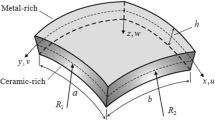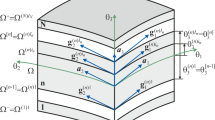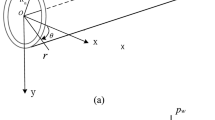Abstract
We study the influence of the residual stresses on the size and character of the variations in the strain intensity and moment intensity coefficients in a closed cylindrical shell welded together from two parts and under the action of axisymmetric loads. We perform a numerical analysis in the case when the shell with residual stresses is acted on by internal pressure.
Similar content being viewed by others
Literature cited
V. A. Osadchuk,The Stress-deformed State and Limit Equilibrium of Shells with Incisions [in Russian], Naukova Dumka, Kiev (1985).
V. A. Osadchuk and A. M. Margolin, “A nondestructive experimental/theoretical method of determining the residual stresses in cylindrical glass shells,” in:Quality, Durability, Reliability, and Technological Usefulness of Electrovacuum Devices [in Russian], Naukova Dumka, Kiev (1976), pp. 55–69.
V. A. Osadchuk and Ya. S. Podstrigach, “Toward the determination of the stressed state in a closed cylindrical shell and an infinite plate with cracks,”Izv. Akad. Nauk SSSR, Mekh. Tverd. Tela, No. 3, 69–78 (1973).
Ya. S. Pidstrigach and V. A. Osadchuk, “On the determination of the stressed state in a closed cylindrical cracked shell,” [in Ukrainian],Dop. Akad. Nauk Ukr. RSR, Ser. A, No. 1, 79–83 (1972).
Ya. S. Podstrigach, A. M. Margolin, and V. A. Osadchuk, “An experimental-theoretical method of accelerated testing of glass-shell electrovacuum devices to evaluate their durability under long storage (determination of the reliability of complex components of glass-shell electrovacuum devices),” Preprint No. 95, Akad. Nauk Ukr. SSR, Fiz.-Mekh. Inst., L'vov (1985).
Ya. S. Podstrigach and V. A. Osadchuk, “On the determination of the stressed state of thin shells taking account of deformations caused by physico-chemical processes,”Fiz.-Khim. Mekh. Mater.,4, No. 2, 218–224 (1968).
Ya. S. Podstrigach, V. A. Osadchuk, and L. P. Karasev, “Approximate computation of the residual weld stresses in cylindrical shells,”Probl. Prochn., No. 7, 8–13 (1975).
G. V. Ryazanov, “On the measurement of weld stresses in glass by the photoelastic method,”Vopr. Radioelek., Ser. 4, No. 1, 55–66 (1961).
A. N. Tikhonov and V. Ya. Arsenin,Methods of Solving Ill-posed Problems [in Russian], Nauka, Moscow (1979).
Additional information
Translated fromMatematicheskie Metody i Fiziko-Mekhanicheskie Polya, Issue 27, 1988, pp. 40–45.
Rights and permissions
About this article
Cite this article
Osadchuk, V.A. Residual stresses in a closed cylindrical shell with a longitudinal crack. J Math Sci 62, 2531–2536 (1992). https://doi.org/10.1007/BF01099144
Received:
Issue Date:
DOI: https://doi.org/10.1007/BF01099144




